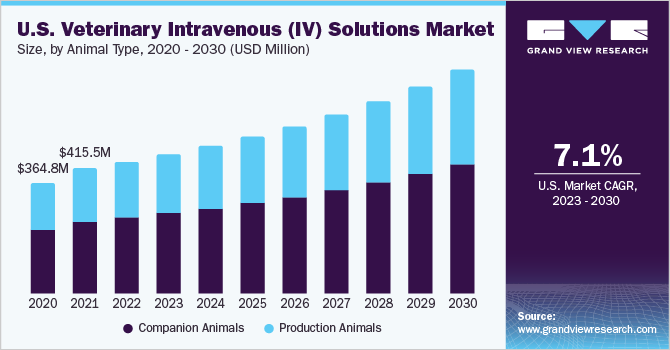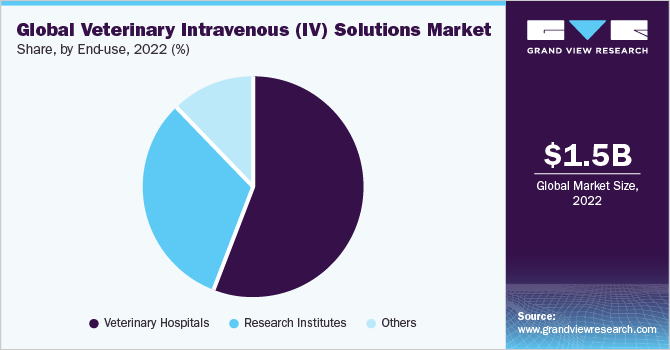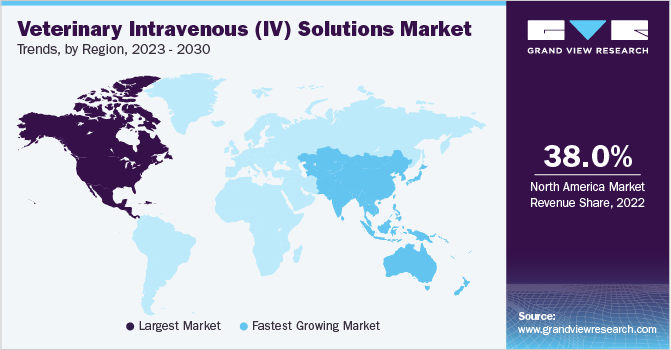- Home
- »
- Animal Health
- »
-
Veterinary Intravenous (IV) Solutions Market Report, 2030GVR Report cover
![Veterinary Intravenous (IV) Solutions Market Size, Share & Trends Report]()
Veterinary Intravenous (IV) Solutions Market Size, Share & Trends Analysis Report By Product, By Animal Type (Companion Animals, Production Animals), By Indication, By End-use, By Region, And Segment Forecasts, 2023 - 2030
- Report ID: GVR-4-68040-099-7
- Number of Report Pages: 150
- Format: PDF, Horizon Databook
- Historical Range: 2018 - 2021
- Forecast Period: 2023 - 2030
- Industry: Healthcare
Report Overview
The global veterinary intravenous (IV) solutions market size was estimated at USD 1.48 billion in 2022 and is expected to grow at a compound annual growth rate (CAGR) of 8.37% from 2023 to 2030. Key factors driving the market growth include increasing pet ownership, the prevalence of diseases such as anthrax, pancreatitis, and oral disease, and rising awareness about animal welfare. There has been a noticeable increase in the prevalence of various animal diseases and conditions, leading to a higher demand for veterinary IV fluid therapy. Conditions such as disease, dehydration, infections, and surgical procedures often require intravenous fluid administration to support the animal's health and recovery.

Anthrax is a serious infectious disease caused by the bacteria Bacillus anthracis. While anthrax primarily affects livestock animals such as cattle, sheep, and goats, it can also affect other domesticated animals and wildlife. Anthrax is more commonly found in certain regions of the world, known as endemic regions. These regions often have specific environmental conditions that favor the survival and growth of the Bacillus anthracis bacteria. Some examples of regions with a higher prevalence of anthrax in animals include parts of Africa, Asia, and parts of Europe. For instance, according to an article published by the National Library of Medicine in 2021, Anthrax was found to be most prevalent in Africa with 28% and 21% in North America.
The COVID-19 pandemic had a severe impact on various industries, including the veterinary sector and the market for veterinary intravenous (IV) fluids. Veterinary clinics and hospitals had to adapt their operations to comply with health and safety guidelines during the pandemic. This included implementing social distancing measures, reducing in-person visits, and prioritizing telemedicine or remote consultations. These changes may have impacted the need for IV fluids, as some procedures or treatments that require intravenous administration may have been modified or delayed. Moreover, during the pandemic, many veterinary clinics and hospitals experienced changes in their priorities. Non-essential and elective procedures were postponed or canceled, and the focus shifted toward urgent and emergency cases. This shift in priorities may have affected the demand for veterinary IV fluids.
The fluid treatment is one of the most popular therapies in small animal medicine. In veterinary medicine, intravenous fluid treatment is frequently used to treat dehydration, restore intravascular volume, and provide intravenous (IV) drugs. The ability to put IV catheters is a fundamental nursing skill for veterinary technologists and enables IV fluid therapy for hospitalized patients and emergency presentations. Access to the vascular area also enables other treatments, such as parenteral nutrition, transfusions, and medicines.
The need for nutrition-rich food and a focus on food safety has become increasingly important in the veterinary IV solutions market. Nutrition plays a vital role in supporting the health and recovery of animals, especially those receiving intravenous fluid therapy. IV fluids can be supplemented with essential nutrients, such as vitamins, minerals, and amino acids, to provide complete and balanced nutrition. The demand for nutrition-rich IV fluids has increased as veterinarians recognize the importance of meeting the nutritional needs of animals during illness, surgery, or critical care.
Product Insights
By product, the isotonic crystalloids segment dominated the market with a share of over 42% in 2022. Isotonic crystalloid solutions are commonly used in veterinary medicine for fluid therapy to restore and maintain hydration and electrolyte balance in animals. Isotonic fluids contain the same osmolality as extracellular fluids. As a result, they are great solutions for rehydration and maintenance needs, particularly because they can be provided intravenously, intraosseously, subcutaneously, and intraperitoneally. Lactated Ringer's, 0.9 percent (physiologic or normal) saline, Ringer's, acetated Ringer's, and 2.5% dextrose in 0.45% saline are examples of commonly used isotonic solutions.
The dextrose solutions segment is anticipated to grow at the fastest CAGR of about 8.96% from 2023 to 2030. Dextrose, also known as glucose, is a type of sugar that can be administered intravenously to supply a readily available source of energy to the animal's body. Veterinary dextrose solutions can also provide hydration support. By administering dextrose solutions intravenously, water is delivered along with the glucose, helping to maintain proper hydration levels in animals that may be dehydrated or unable to drink water adequately.
Animal Type Insights
The companion animal segment dominated the market with a revenue share of over 57% in 2022. Companion animals, particularly, dogs and cats, are commonly kept as pets in many households. The high rate of pet ownership contributes to the significant demand for veterinary IV fluids, as these animals often require intravenous therapy for various health conditions, surgeries, or critical care situations. Pet owners today have a greater emphasis on providing high-quality healthcare for their companion animals. This includes seeking veterinary care, preventive measures, and advanced treatments when necessary. Intravenous fluid therapy is a crucial component of comprehensive veterinary care, leading to the increased demand for IV fluids in the companion animal segment.
The production animals segment is expected to witness lucrative CAGR during the forecast period, due to the increasing prevalence of mouth disease in farm animals. For example, animals with cloven hooves, such as cattle, pigs, sheep, and goats, are most commonly affected by the extremely contagious viral disease known as foot-and-mouth disease. While it mainly causes lesions on the feet and mouth, the disease can spread rapidly and have a significant economic impact due to restrictions on animal movement and trade.
Indication Insights
The Diabetic Ketoacidosis (DKA) segment dominated the market with a revenue share of over 28% in 2022. The prevalence of DKA in animals is directly linked to the prevalence of diabetes mellitus in the animal population. Diabetes mellitus, which can be either type 1 or type 2, is relatively common in companion animals, particularly dogs and cats. The incidence of diabetes in animals has been increasing in recent years, potentially leading to a higher prevalence of DKA cases. Intravenous fluid treatment is an essential component of managing diabetic ketoacidosis (DKA) in animals. DKA is a serious and potentially life-threatening complication of diabetes mellitus characterized by hyperglycemia, ketosis, and metabolic acidosis. The intravenous fluid treatment for DKA in animals aims to correct dehydration, restore electrolyte balance, and provide glucose and insulin therapy.
The others segment is expected to witness a lucrative CAGR during the forecast period. The others segment include vomiting, diarrhea, and dehydration. Diarrhea is a frequent presenting condition in companion animal practice; it is either more common in dogs than in cats, or dogs with diarrhea are more likely to be evaluated by a veterinarian. Young puppies are considerably more likely to experience both diarrhea and vomiting, and the risk of developing diarrhea falls from 16% in 7- to 12-week-old puppies to 5.4% in 12- to 18-month-old dogs.
End-use Insights
The veterinary hospital segment dominated the market with a revenue share of over 55% in 2022 because more pet owners are taking their animals to hospitals for treatment. Veterinary hospitals often utilize IV fluid therapy as a fundamental component of patient care. Veterinary hospitals are equipped to handle emergencies and provide immediate and intensive care to animals in critical conditions. IV solutions are frequently used in emergencies to stabilize patients, address shock, and ensure prompt delivery of necessary medications and fluids.

The others segment is expected to witness a lucrative CAGR during the forecast period. Veterinary home care settings involve providing medical care and treatment for animals in the comfort of their own homes rather than in a traditional veterinary clinic or hospital setting. In such settings, veterinary professionals visit the pet owner's home to provide various healthcare services, including the administration of veterinary IV solutions. Veterinary home care offers convenience and comfort to both the animals and their owners. It eliminates the stress and anxiety associated with transporting animals to a clinic and allows them to receive care in a familiar environment.
Regional Insights
North America held the highest revenue share of over 38.0% in 2022. North America has a significant pet ownership rate, with a large number of households owning companion animals such as dogs, cats, and small mammals. The high demand for veterinary care for these pets contributes to the demand for veterinary IV solutions. Moreover, the veterinary industry in North America has witnessed technological advancements in IV solutions, such as the development of specialized IV administration sets, infusion pumps, and fluid management systems. These advancements enhance the efficiency, accuracy, and safety of IV fluid administration, improving patient care.

Asia Pacific is anticipated to grow at the fastest CAGR during the forecast period. Many countries in the Asia Pacific region have been investing in the development and expansion of veterinary healthcare infrastructure. This includes the establishment of veterinary clinics, hospitals, and specialized veterinary centers, which contribute to the increased demand for veterinary IV solutions. The Asia Pacific region is home to a substantial livestock population, including cattle, pigs, poultry, and other animals. Veterinary IV solutions play a crucial role in the healthcare and management of livestock, supporting their well-being, productivity, and disease management.
Key Companies & Market Share Insights
Due to the number of companies offering veterinary intravenous solutions, the industry is fairly competitive. These companies use many different types of strategies to increase their market presence and share. These initiatives include partnerships and collaborations, mergers and acquisitions, R&D, geographical expansion, product launches, and other activities. In January 2023, for example, Merck & Co., Inc. acquired Imago BioSciences, Inc. After the completion of this merger Imago will transform into a fully owned subsidiary of Merck. Some prominent players in the global veterinary intravenous (IV) solutions market include:
-
Merck & Co., Inc.
-
Dechra Veterinary Products
-
Sypharma
-
Animalcare
-
B. Braun SE
-
Woods Consulting, LLC
-
Baxter
-
Fresenius Kabi
Veterinary Intravenous (IV) Solutions Market Report Scope
Report Attribute
Details
Market size value in 2023
USD 1.58 billion
Revenue forecast in 2030
USD 2.67 billion
Growth rate
CAGR of 8.37% from 2023 to 2030
Base year for estimation
2022
Historical data
2018 - 2021
Forecast period
2023 - 2030
Quantitative units
Revenue in USD million/billion and CAGR from 2023 to 2030
Report coverage
Revenue forecast, company ranking, competitive landscape, growth factors, trends
Segments covered
Product, animal type, indication, end-use, region
Regions covered
North America; Europe; Asia Pacific; Latin America; MEA
Country scope
U.S.; Canada; UK; Germany; Italy; France; Spain; Denmark; Sweden; Norway; Japan; China; India; South Korea; Australia; Thailand; Brazil; Mexico; Argentina; South Africa; Saudi Arabia; UAE; Kuwait
Key companies profiled
Merck & Co., Inc.; Dechra Veterinary Products; Sypharma; Animalcare; B. Braun SE; Woods Consulting, LLC; Baxter; Fresenius Kabi
Customization scope
Free report customization (equivalent up to 8 analysts’ working days) with purchase. Addition or alteration to country, regional & segment scope.
Pricing and purchase options
Avail customized purchase options to meet your exact research needs. Explore purchase options
Global Veterinary Intravenous (IV) Solutions Market Report Segmentation
This report forecasts revenue growth and provides an analysis of the latest trends and opportunities in each of the sub-segments from 2018 to 2030. For this report, Grand View Research has segmented the veterinary intravenous (IV) solutions market report based on product, animal type, indication, end-use, and region:
-
Product Outlook (Revenue, USD Million, 2018 - 2030)
-
Isotonic crystalloids
-
Synthetic colloids
-
Blood products
-
Dextrose solutions
-
Parenteral nutrition
-
-
Indication Outlook (Revenue, USD Million, 2018 - 2030)
-
Diabetic Ketoacidosis
-
Pancreatitis
-
Anthrax
-
Chronic Kidney Disease
-
Others
-
-
Animal type Outlook (Revenue, USD Million, 2018 - 2030)
-
Companion Animals
-
Production Animals
-
-
End-use Outlook (Revenue, USD Million, 2018 - 2030)
-
Veterinary Hospitals
-
Research Institutes
-
Others
-
-
Regional Outlook (Revenue, USD Million, 2018 - 2030)
-
North America
-
U.S.
-
Canada
-
-
Europe
-
UK
-
Germany
-
France
-
Italy
-
Spain
-
Denmark
-
Sweden
-
Norway
-
-
Asia Pacific
-
Japan
-
China
-
India
-
South Korea
-
Australia
-
Thailand
-
-
Latin America
-
Brazil
-
Mexico
-
Argentina
-
-
Middle East & Africa
-
South Africa
-
Saudi Arabia
-
UAE
-
Kuwait
-
-
Frequently Asked Questions About This Report
b. The global veterinary intravenous (IV) solutions market size was estimated at USD 1.48 billion in 2022 and is expected to reach USD 1.58 billion in 2023.
b. The global veterinary intravenous (IV) solutions market is expected to grow at a compound annual growth rate of 8.37% from 2023 to 2030 to reach USD 2.67 billion by 2030.
b. North America dominated the veterinary intravenous solutions market with a share of 38.24% in 2022. North America has a significant pet ownership rate, with a large number of households owning companion animals such as dogs, cats, and small mammals. The high demand for veterinary care for these pets contributes to the demand for veterinary IV solutions.
b. Some key players operating in the Veterinary Intravenous Solutions market include Merck & Co., Inc.; Dechra Veterinary Products; Sypharma; Animalcare; B. Braun SE; Woods Consulting, LLC; Baxter; Fresenius Kabi.
b. Key factors that are driving the veterinary intravenous solutions market growth include increasing pet ownership, increasing the prevalence of diseases such as anthrax, pancreatitis, and oral disease, and raising awareness of animal welfare.
Share this report with your colleague or friend.
![gvr icn]()
NEED A CUSTOM REPORT?
We can customize every report - free of charge - including purchasing stand-alone sections or country-level reports, as well as offer affordable discounts for start-ups & universities. Contact us now
![Certified Icon]()
We are GDPR and CCPA compliant! Your transaction & personal information is safe and secure. For more details, please read our privacy policy.
We are committed towards customer satisfaction, and quality service.
"The quality of research they have done for us has been excellent."





